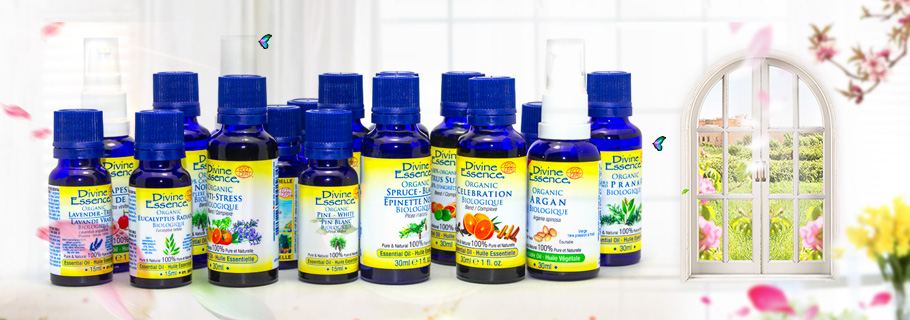In this last part of our guide, we’re aiming to help you integrate the different aspects covered by the two previous installments of this series. This guide is meant to provide you with a useful starting point for picking out oils and creating harmonious scents, but it is by no means an end point nor a series of rules to follow to the letter: experimentation is absolutely key to the process!
Choosing the right products
When choosing essential oils, it’s important to try and pick ones that are organic: not just for the planet, but for the added aromatherapeutic benefits. The Divine Essence we carry at Lierre, for example, picks out the ingredients from which they extract their oils carefully, and respect both organic and ethical criteria.
In many cases, it isn’t just the essential oils you’re trying to choose, but the medium in which you infuse them. The same rule of thumb applies here: organic, locally and ethically sourced brands tend to be of higher quality, and it’s easier to combine the essential oils uniformly in these types of products. For example, L’Herbier’s Neutral Balm makes a particularly wonderful carrier base for essential oils, since the locally sourced beeswax from which it is made is of much higher quality – and therefore much smoother – than competing brands.
If you’re hesitating between using a massage oil, gel, cream, lotion or balm, you may want to consult our article on the subject explaining their different advantages and disadvantages. If you’re considering making a massage bar, we also have a recent blog post that gives you a detailed run-down of how to proceed. The carrier medium you end up choosing may not affect the particular oils you choose to use, but it’s very likely to determine the proportion of base, heart and top note essential oils that will work best for you.
How to pick essential oils for a blend
If you’ve read the previous installments of this article, you should have a basic grasp of the different functions of essential oils as well as a loose idea as to how to match them. After having considered what kind of
purpose you want to achieve your essential oil blend, you should have narrowed your search for ingredients down to a short list of ingredients that may be suitable. For example, camphor, peppermint and spike lavender all work as analgesics, but they’re also from different scent families. You may already have a preference for one of these: from there, you can try and find different groups of scents that will complement your essential oil of choice appropriately.
Following the last example, you may prefer to use peppermint, a sharp, fresh-smelling herb, which complements arboreal scents particularly well. A top note, it can therefore be paired successfully with cedarwood, a base note. If you wish to accentuate the analgesic and decongestant effects of peppermint, eucalyptus would be a good choice of heart note; otherwise, other herbs such as rosemary could complement the mix as well.
Determining the proper proportion for such a mix, then, also depends on its use: in a massage oil, the heart and top notes should dominate, with for example 4 drops of peppermint, 5 drops of eucalyptus and one or two drops of cedarwood. In a massage bar, however, which tends to be used over longer periods of time, the proportion of cedarwood could be increased to 3 or 4 drops, the eucalyptus could stay at 5 drops and the peppermint could be only 2. You could add a drop of two of spike lavender to either of these mixes for a more complex scent. It’s important to try different proportions of these oils first, using testing bottles or scent strips, before committing to using large amounts.
When looking to create your own signature blend of essential oils, whether it is intended for diffusion or for massage products, a good rule is to always consider function first, and to build your list of ingredients from there. Proportions of essential oils also vary according to the carrier base, which should also be determined according to function and quality. Discovering different families of scent and experimenting with related aromas is a much better way to achieve a favourable result than simply combining your favourite essential oils, which more often than not won’t complement each other. Different essential oils will have a scent that will achieve its fullest effect in varying time frames, and certain types of scents only mask or even bring out the negative qualities in another.
Though we haven’t mentioned it yet, perhaps the most important part of the whole process is to enjoy yourself! Creating your perfect mix is an art, not a science, and it should ultimately be a fun, exploratory process, rather than a tedious exercise. On a final (heart) note, we wish you best of luck with your blends, and happy mixing!
Lierre offers only the finest quality of organic, fair trade essential oils from the Divine Essence lines. Our essential oils are selected for their therapeutic qualities as well as their outstanding scents, and we aim to accomodate massotherapists and aromatherapy enthusiasts alike.These essential oils can be diffused, poured into a foaming bath, integrated into a wide variety of skin care and massage products, and even mixed into wax to create scented candles – the possibilities are inexhaustible!
If you are interested essential oils or related products, you can visit at Lierre Essential Oils. Lierre offers the best quality acupuncture needles, massage tables, cupping set, massage accessories, personal care products and more at great prices.
All rights reserved for Lierre Blog

